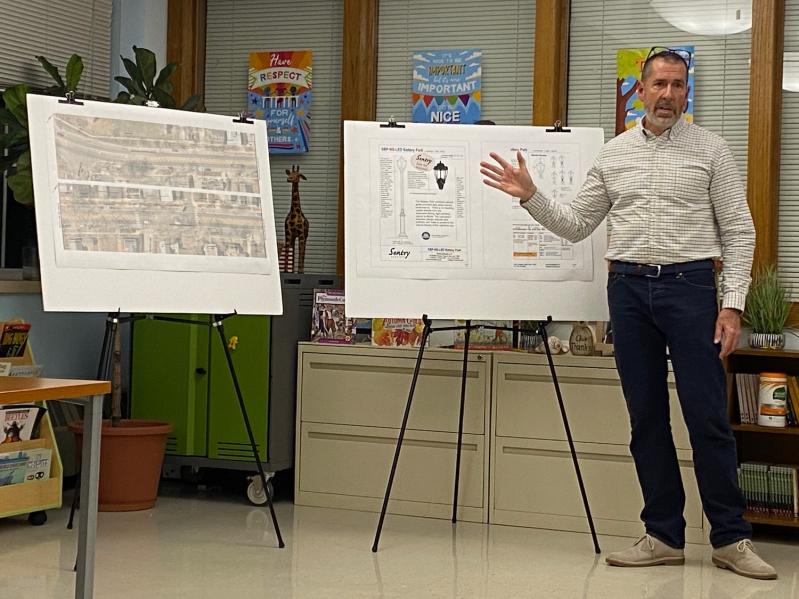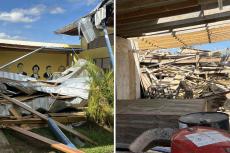The wheels of appropriate street lighting in a historic district grind slowly, but a near-hourlong discussion of a plan, some five years in the making, to replace fixtures in Amagansett’s historic district at Monday’s meeting of the hamlet’s citizens advisory committee moved the project incrementally forward on Monday.
Matt Jedlicka of the L.K. McLean Associates consultancy presented a plan that closely tracked one given to the East Hampton Town Board one year ago. That plan, he said, calls for 46 to 50 “historical style” light fixtures such as those installed in Sag Harbor, spaced approximately 100 feet apart on either side of Main Street from Windmill Lane to Meeting House Lane. The existing “cobra head” lights affixed to metal poles would be removed.
The committee’s lighting subcommittee also seeks streetlights on the north side of Main Street from Meeting House Lane to the hamlet’s firehouse, which Mr. Jedlicka said would likely be of a bollard design. Rona Klopman, the committee’s chairwoman, said that was at the request of teachers at the Amagansett School who take the Long Island Rail Road. “This time of year, it gets dark at 4 o’clock,” she noted.
“Essentially, the purpose of this is to get some pedestrian safety,” Mr. Jedlicka said, citing “a lot of dark spots,” including near the hamlet’s library. L.K. McLean Associates is proposing a 2,700 kelvin LED lamp, the measurement indicating a “soft white” or warm, yellowish light that resembles an old incandescent bulb. All lights, he said, would be set in the top of the fixtures and directed downward. No trees or planters would be removed to accommodate the new fixtures.
The proposed lights would be on from dusk to dawn, he said. The cost of the upgrade would be imposed on the Amagansett Main Street tax district and not townwide.
The slow pace at which the project is moving, he said, is due to the hamlet’s Main Street also being a state highway, requiring New York State Department of Transportation input. When doing a feasibility study, there was discussion of burying utility lines, he said, which required discussion with and site visits by PSEG Long Island and Verizon. The suggestion was later abandoned and the project refocused on its original intent, public safety, Mr. Jedlicka said.
Several of those attending cited two incidents in which a pedestrian was killed crossing Main Street, one of them the hit-and-run death of John Judge in October 2012.
Where the cobra head lights are more than 20 feet high, “these [new] lights will be much lower,” Mr. Jedlicka said, most likely 10 to 12 feet. That decision, said Councilman Tom Flight, the town board’s liaison to the committee, “was about minimal impact to trees,” which he called the “main characteristic” of Main Street.
There was discussion among committee members and others as to how well lighted the historic district is at present. “When I come in to Amagansett and it’s summer,” Ms. Klopman said, people, often dressed in dark clothing, cross the street from Amagansett Square to the Stephen Talkhouse, forgoing a nearby crosswalk. “I can’t see them,” she said.
That, said Jaine Mehring of the committee, is a traffic and pedestrian issue. “I don’t see this as necessarily consistent with a historic district,” she said of the lighting plan. “I don’t see where dark spots are.”
Jaywalking is not illegal, Mr. Flight observed. “This allows more of Main Street to be lit, so when people are jaywalking, you can see them more clearly,” he said.
Dan Mongan, a resident of the hamlet, raised several questions and concerns. “What’s extremely important for the process,” he said, is “a written document proposing a plan. The only thing I’ve seen is a feasibility study,” posted on the town’s website, “which does not reflect the current plan as described.”
That study is “very similar to this plan as it exists now,” Mr. Jedlicka replied. At the point of the feasibility study, he said, “we hadn’t been hired to pursue anything further.” After a presentation to the board, L.K. McLean was hired to do an engineering study and prepare a final document, which he said has yet to be completed. More time is needed to work with utility companies and the state before it can be shared with the public, he said.
“We invited Matt back here to show how far” the plan has come, Ms. Klopman said.
Were the pedestrian fatalities related to lighting, Mr. Mongan asked. There have been two deaths in the same place, replied Dawn Brophy, secretary of the committee. “I lived there, I was brought up on Main Street,” she said. “I don’t need an analysis. I know that that’s a dangerous spot . . . a very, very dangerous spot.”
“That’s an issue confined to a specific location, not the whole street,” Mr. Mongan said. He asked if the problem being addressed was road safety or safety on footpaths. Mr. Jedlicka’s study of light output from the proposed fixtures addresses both, Mr. Flight said, but is designed to cover the roadway.
The plan, “as it’s laid out, covers both the road and the sidewalk,” said John Broderick, a lighting and production designer who has worked extensively with the rock-and-roll band Metallica, which coincidentally performed at the Stephen Talkhouse in August, an event that drew thousands to the hamlet and provoked more than a little annoyance among some committee members. The proposed lighting is below the tree line, he said, which will be effective.
“You seem to have a vehement opposition to this,” he told Mr. Mongan.
“I’m asking questions,” Mr. Mongan replied, suggesting that the proposed lighting would trespass onto Main Street properties.
There would be very little light trespass onto property, Mr. Jedlicka said, describing “a very targeted, specific light.”
But “if you start potentially over-lighting,” Ms. Mehring said, “this is going to be a very, very significant alteration of our historic district.”
The lights will be 100 feet apart — “They’re not lined up like chessmen,” Mr. Broderick said. “The cobras are horrible, and the LEDs in them are horrible because they spread too far.”
Mr. Mongan suggested that “if we want to deal with this, let’s look at crosswalks and make them work,” stating that none of the crosswalks in the town are “properly designed and safe.”
But that, said Michael Cinque, a member of the committee and a Main Street business owner, will have no impact on jaywalkers going to the Stephen Talkhouse. “It’s jungle rules there,” he said. “Crosswalks are just going to back up traffic even more.”
The town board will consider the matter at an upcoming work session, Mr. Flight said. “This change, in my opinion, will be a more significant change to the historic district that has been preserved for some years than anything we’ve ever talked about,” he said. “So let’s think about it.”




